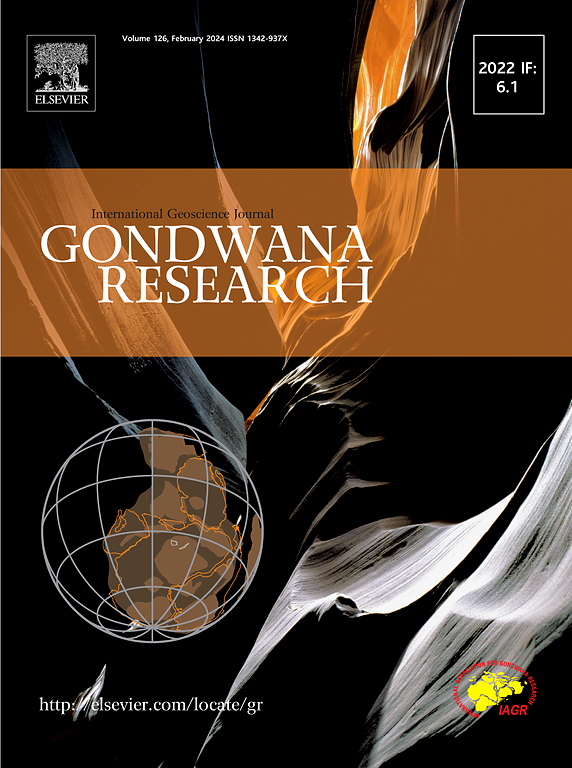通过减少空气污染实现城市低碳产业发展:时空协同视角
IF 7.2
1区 地球科学
Q1 GEOSCIENCES, MULTIDISCIPLINARY
引用次数: 0
摘要
城市空间中空气污染物和二氧化碳排放的一致性提出了一个关于城市可持续发展的关键问题:减少空气污染(APR)的努力是否能导致碳排放的减少和生产力的提高,从而促进城市工业向低碳发展的过渡。利用社会经济指标和卫星数据,研究了中国280个城市的APR与工业全要素碳生产率(ITFCP)的时空协同效应。研究结果表明,中国城市的平均积雪面积与城市积雪面积均呈上升趋势,表现出较强的长期正动态相关关系,平均积雪面积对城市积雪面积的正向影响表现出滞后效应。耦合协调度(CCD)不断增强,年平均增长率为1.50%。此外,我们发现APR和ITFCP之间存在显著的局部和空间协同效应。京、津、渝已进入中间耦合协调阶段((0.6,0.8))。然而,280个城市中有61.4%仍处于轻度非均衡阶段((0.2,0.4])。尽管CCD在所有地区总体呈上升趋势,但西部城市存在下降的潜在风险。其复杂的网络结构向长三角、珠三角、京津冀等重点城市群辐射,形成了广泛的辐射效应。CCD呈正相关,高值区集中在东部沿海城市,低值区集中在内陆城市。综上所述,APR与ITFCP在空间和时间上的强一致性和高关联度表明,APR确实可以协同减少碳排放和提高生产率,是推进城市工业低碳发展的可行策略。本文章由计算机程序翻译,如有差异,请以英文原文为准。

Towards urban low-carbon industrial development through air pollution reduction: A spatiotemporal synergy perspective
The consistency of air pollutant and carbon dioxide emissions in urban spaces raises a critical topic for sustainable urban development: Whether efforts to reduce air pollution (APR) can lead to a decrease in carbon emissions and enhance productivity, thereby facilitating the transition of urban industries to low-carbon development. This study amalgamates diverse datasets, including socio-economic indicators and satellite-derived information, to investigate the spatiotemporal synergy between APR and industrial total factor carbon productivity (ITFCP) in 280 cities of China. Our initial findings indicate that both APR and ITFCP in Chinese cities are on an upward trajectory, exhibiting a strong positive long-term dynamic correlation, and the APR’s positive influence on ITFCP shows a delayed effect. Additionally, the coupling coordination degree (CCD) is intensifying, with an average annual growth rate of 1.50%. Furthermore, we identify a significant local and spatial synergies between APR and ITFCP. Beijing, Tianjin, and Chongqing have entered a stage of intermediate coupling coordination ((0.6,0.8]). However, 61.4 % of the 280 cities are still in the stage of mild disequilibrium ((0.2,0.4]). Although the CCD has seen an overall upward trend across all regions, there is a potential risk of a downward shift in the western cities. The complex network structure of APR and ITFCP radiates from key urban clusters such as the Yangtze River Delta, the Pearl River Delta, and the Beijing-Tianjin-Hebei, creating a broad radiation effect. The CCD exhibits positive spatial correlations, with high-value areas concentrated along the eastern coastal cities and lower values in inland cities. In conclusion, the strong consistency and high association of APR and ITFCP in both space and time suggest that APR can indeed synergistically reduce carbon emissions and boost productivity, making it a viable strategy for advancing the urban industry’s low-carbon development.
求助全文
通过发布文献求助,成功后即可免费获取论文全文。
去求助
来源期刊

Gondwana Research
地学-地球科学综合
CiteScore
12.90
自引率
6.60%
发文量
298
审稿时长
65 days
期刊介绍:
Gondwana Research (GR) is an International Journal aimed to promote high quality research publications on all topics related to solid Earth, particularly with reference to the origin and evolution of continents, continental assemblies and their resources. GR is an "all earth science" journal with no restrictions on geological time, terrane or theme and covers a wide spectrum of topics in geosciences such as geology, geomorphology, palaeontology, structure, petrology, geochemistry, stable isotopes, geochronology, economic geology, exploration geology, engineering geology, geophysics, and environmental geology among other themes, and provides an appropriate forum to integrate studies from different disciplines and different terrains. In addition to regular articles and thematic issues, the journal invites high profile state-of-the-art reviews on thrust area topics for its column, ''GR FOCUS''. Focus articles include short biographies and photographs of the authors. Short articles (within ten printed pages) for rapid publication reporting important discoveries or innovative models of global interest will be considered under the category ''GR LETTERS''.
 求助内容:
求助内容: 应助结果提醒方式:
应助结果提醒方式:


